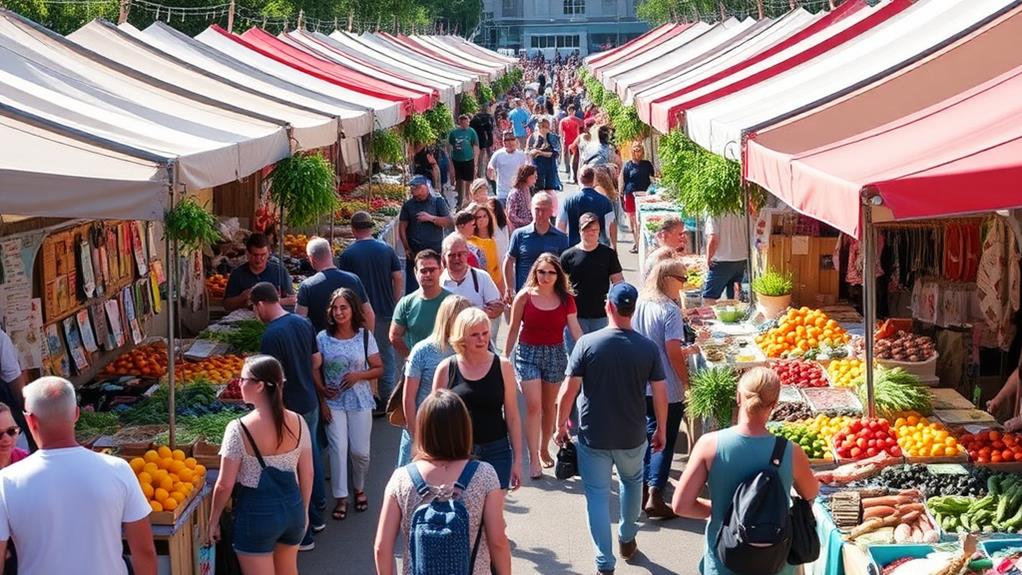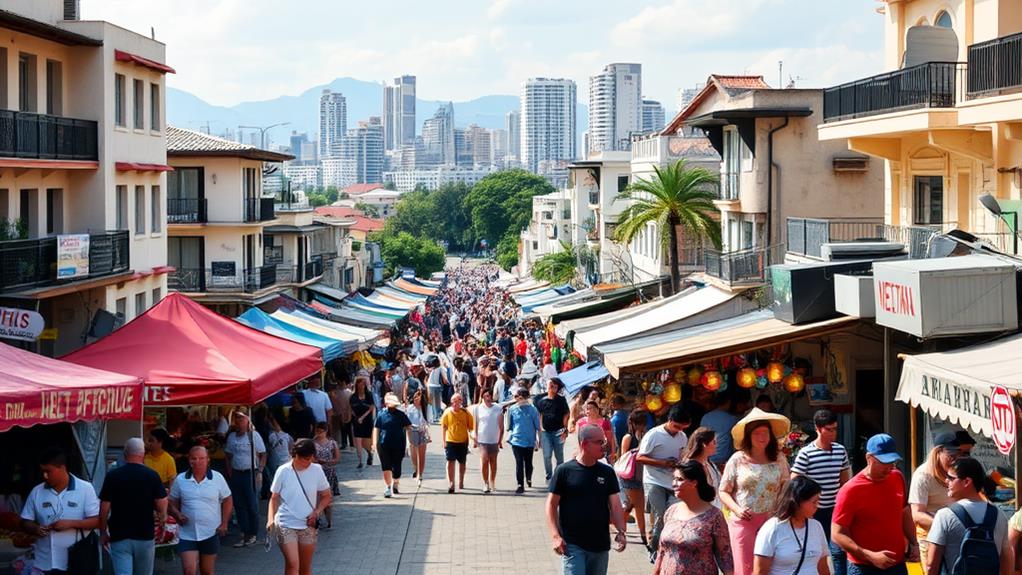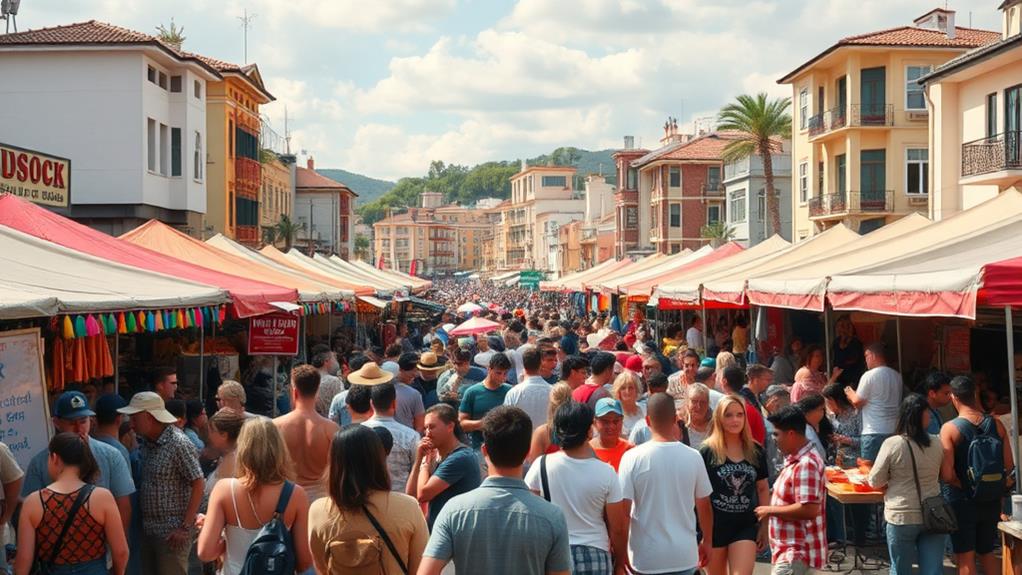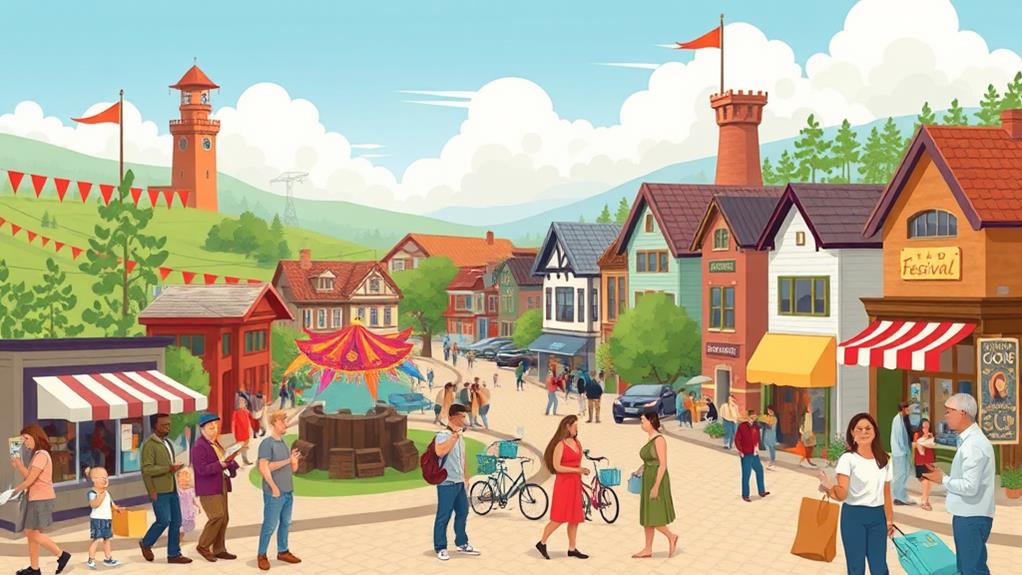Local festivals can have a significant impact on regional economies. Research has shown that these events can generate millions of dollars in revenue from visitor spending. This economic boost can be attributed to the influx of tourists and their spending on local hospitality services, such as hotels, restaurants, and shops.
The economic impact of a festival is influenced by several key factors. Average spending per visitor is one such factor, as it directly affects the total revenue generated. For example, a festival that attracts 10,000 visitors with an average spending of $100 per person can generate $1 million in revenue.
The total number of visitors is another crucial factor, as it determines the overall demand for local services and products. A festival that attracts a large number of visitors is likely to have a greater economic impact than one with fewer attendees.
Community engagement is also a vital factor in determining the economic impact of a festival. When local residents are involved in the planning and organization of the event, they are more likely to support it by attending and encouraging others to do so. This can lead to increased visitor numbers and spending, resulting in a greater economic impact.
To maximize the economic potential of a festival, organizers can implement various strategies. Dynamic pricing is one such strategy, where ticket prices are adjusted based on demand. For example, prices can be lower during off-peak periods and higher during peak periods.
Sustainable tourism practices are also essential, as they can help reduce the environmental impact of the festival and promote local businesses.
Understanding Economic Impact

Festivals have a significant economic impact on local communities. To understand this impact, various analysis methods and metrics are used.
Visitor surveys, hotel occupancy rates, and tax revenue analysis are some of the techniques used to assess spending patterns and tourism trends. These methods help gauge the effects of festivals on the local economy.
Accurately estimating the total economic benefits generated by festivals requires analyzing visitor spending patterns. Average spending per visitor and the total number of visitors are key factors to consider. Data collection methods like ticketing information, point-of-sale data from vendors, and transportation data help determine spending from out-of-town visitors.
Input-output modeling techniques, such as the IMPLAN model, are commonly used to analyze the economic impact of festivals. These techniques consider not just direct effects from visitor spending but also indirect and induced impacts on the local economy.
For example, a festival may create jobs for local residents, who then spend their earnings on goods and services, further stimulating the economy. By using these methods, a deeper understanding of how festivals contribute to the local economy can be gained.
Measuring Festival Benefits
Measuring a festival's economic benefits requires a multi-faceted approach. This approach involves combining visitor surveys, data collection on spending patterns, and modeling techniques.
Visitor surveys are crucial for determining per person spending. A reliable survey should aim for at least 400 respondents, depending on the event size. When designing the survey, include questions about demographics, travel habits, and expenditure to gain a comprehensive understanding of visitor behavior. For instance, a survey for a music festival might ask: 'What is your age?', 'How many people are you traveling with?', and 'What is your estimated daily expenditure?'.
Data collection methods provide valuable insights into visitor demographics and spending behavior. Ticketing information, gate counts, and transportation data can be used to collect this information. For example, analyzing ticket sales can reveal the number of attendees and their geographic distribution. Gate counts can help determine the number of people entering the festival at different times.
Input-output models assess indirect and induced effects. Models like the IMPLAN model extend the analysis beyond direct effect measurements. Direct effects refer to the immediate spending by visitors, while indirect effects are the increased economic activity in industries that supply goods and services to the festival.
Induced effects are the increased economic activity resulting from the spending of festival employees and suppliers. For example, a festival might directly employ staff and vendors (direct effect), who then spend their earnings at local businesses (induced effect).
Maximizing Economic Potential

Maximizing Economic Potential of Festivals
Understanding the Economic Benefits
Festivals can have a lasting impact on a community by maximizing their economic benefits. To achieve this, event organizers can focus on three main strategies: partnering with local businesses, optimizing revenue generation, and promoting local attractions.
Partnering with Local Businesses
Partnering with local businesses can boost local economic activity. For example, creating package deals for attendees can increase visitor spending and enhance the overall economic impact on the community.
A package deal can include festival tickets, accommodation, and dining options at local restaurants. This encourages longer visitor stays, resulting in higher spending across accommodation, dining, and local attractions.
Optimizing Revenue Generation
Innovative pricing strategies can optimize revenue generation. Dynamic pricing and customizable ticketing options ensure higher economic returns from festival attendance.
Dynamic pricing involves adjusting ticket prices based on demand, while customizable ticketing options allow attendees to choose specific events or activities. These strategies can increase revenue and create a more personalized experience for attendees.
Promoting Local Attractions
Promoting local attractions in conjunction with festivals can create a comprehensive tourism experience. This drives additional economic activity both during and after the event.
For example, event organizers can offer guided tours of local landmarks or provide information about nearby attractions. This encourages attendees to explore the local area, resulting in increased spending and a more positive economic impact.
Integrating Sustainable Practices
Integrating sustainable practices can enhance the festival experience and contribute to long-term positive economic impacts.
Reducing waste and supporting local suppliers are two key strategies. Event organizers can reduce waste by using recyclable materials, composting food waste, and encouraging attendees to bring reusable containers.
Supporting local suppliers can also reduce the festival's carbon footprint and create jobs in the local community.
Factors Influencing Impact
Size and duration of festivals significantly influence their economic impact. Larger festivals that span multiple days tend to attract more attendees, resulting in higher visitor spending. For example, a three-day music festival will likely have a greater economic impact than a single-day event. This increased duration allows attendees to spend more on accommodations, food, and local attractions.
Accessibility factors also play a crucial role in the economic impact of festivals. Urban festivals benefit from existing infrastructure, such as public transportation, hotels, and restaurants. In contrast, rural festivals may require temporary investments in infrastructure to support increased visitor influx. For instance, a rural festival may need to arrange for shuttle services or set up temporary accommodations to cater to attendees.
Cultural significance and tourist appeal can greatly affect economic outcomes. Festivals that celebrate unique cultural heritage or offer exclusive experiences tend to draw more tourists, leading to greater spending and repeat visitation. For example, a festival featuring traditional music and dance performances may attract tourists interested in cultural experiences.
Community engagement and support are essential for maximizing economic impact. Festivals that foster local participation and pride often see stronger economic outcomes through increased local spending and loyalty from attendees. Festivals can encourage community engagement by offering local vendors opportunities to sell their products or by incorporating local talent into the event lineup.
Accessibility factors, such as transportation options and proximity to major markets, affect attendance rates and economic impact. Festivals that are easily accessible by car or public transportation tend to attract more attendees, resulting in higher visitor spending. For example, a festival located near a major highway or public transportation hub will likely have a greater economic impact than one that's difficult to access.
Benefits Beyond Direct Spending

Festivals generate economic benefits that extend beyond direct visitor spending. These benefits include increased community pride and social ties.
For example, festivals often bring residents together, encouraging them to participate in cultural activities. This strengthened community identity leads to long-term economic benefits for local businesses, as residents become more invested in supporting their community.
Festivals also foster local engagement. Residents who feel connected to their community are more likely to shop at local stores and support local initiatives.
This increased support can lead to long-term economic growth for local businesses.
Economic Impact Analysis
Conducting an economic impact analysis of a festival requires a systematic approach.
To quantify spending patterns and assess tourism trends, you need to gather data through various methods.
To analyze visitor spending habits, you can gather data through visitor surveys, ticketing information, and hotel occupancy rates.
Collecting around 400 completed surveys will provide reliable data.
For indirect and induced effects, input-output modeling can be used.
The IMPLAN model is a suitable example, as it provides a comprehensive understanding of how the festival affects different industries and sectors within the local economy.
Tax revenue generated during the festival period is a key indicator of economic vitality.
Analyzing this revenue will help determine the overall impact of the festival on the local economy.
Strategies for Success

Effective Strategies for Maximizing Festival Revenue
Establishing partnerships with local businesses is crucial for maximizing a festival's financial benefits. This can be achieved by creating package deals that combine festival tickets with accommodations, dining, or local attractions. For instance, offering a 10% discount on accommodations for festival attendees who book through a partner hotel can increase visitor spending and enhance the overall economic impact.
Implementing dynamic pricing strategies for tickets is another effective approach. By using advanced ticketing tools, festival organizers can offer customizable pricing options, such as tiered pricing for tickets based on demand, which can attract a broader audience and enhance the festival experience.
Encouraging extended stays is also vital for increasing spending within the community. This can be done by promoting local attractions and curated experiences. For example, offering a guided tour of local landmarks can lead to increased spending within the community beyond the festival dates.
Community reinvestment programs are also essential for promoting sustainable growth. By allocating a portion of festival revenues back to local initiatives, festival organizers can strengthen community ties and promote sustainable growth. For instance, allocating 10% of festival revenues to support local arts programs can have a lasting impact on the local economy.
Sustainable Tourism Practices
Sustainable practices can significantly reduce the environmental footprint of large-scale events. Implementing waste reduction strategies, such as composting and recycling programs, can decrease the environmental impact of large gatherings.
For example, a festival can reduce its waste by 75% by implementing a composting program and recycling aluminum, plastic, and glass.
To further minimize environmental impact, encouraging the use of public transportation and providing shuttle services can help reduce traffic congestion and lower carbon emissions during festival events. This approach can cut down carbon emissions by 50% compared to individual transportation methods.
Supporting local suppliers and vendors also promotes sustainability by stimulating the local economy and reducing transportation-related emissions. This approach benefits local businesses and the community as a whole.
For instance, a festival can allocate 80% of its budget to local vendors, supporting the local economy and reducing emissions.
Educational initiatives can also be incorporated into festival events to raise awareness about local culture and environmental conservation.
How Do Regional Festivals Like Sinulog Contribute to the Local Economy?
Regional festivals like Sinulog contribute to the local economy by attracting tourists and stimulating business activities. Vendors, hotels, restaurants, and transportation services benefit from the increased demand during the festival. By implementing enhance sinulog festival experience techniques, organizers can further enhance the economic impact of the event.
Long-Term Economic Effects

Festivals can significantly contribute to long-term economic growth. A prime example is the Edinburgh Festival Fringe, which generates approximately £200 million annually for Scotland's economy through sustained tourist interest and spending.
This increased demand attracts long-term investments, leading to higher property values in surrounding areas.
Successful festivals can enhance local branding, making destinations recognizable for their cultural significance. This leads to a 10-15% increase in off-season tourism.
Repeat visits from loyal attendees foster ongoing economic engagement, providing consistent revenue streams for local businesses and increasing the community's overall economic resilience.
Major festivals drive long-term economic growth by supporting local businesses and solidifying their role as a key economic driver in the region.
Boosting Local Economies
Festivals significantly boost local economies through visitor spending on goods and services.
Festivals attract a large number of visitors from outside the local area, resulting in increased spending on accommodation, food, and retail. This increased visitor spending has a direct and positive impact on local businesses, helping to stimulate economic growth and development.
Key ways that festivals boost local economies include:
- Attracting outside visitors: Festivals bring visitors from outside the local area, resulting in increased spending on local goods and services. For example, a music festival in a small town can attract thousands of visitors who spend money on local accommodations, food, and souvenirs.
- Supporting local businesses: Festivals support local businesses by increasing foot traffic and sales. Local restaurants, bars, and shops benefit from the influx of visitors, resulting in increased revenue and job creation.
- Generating revenue for local hospitality sectors: Festivals generate revenue for local hospitality sectors, including hotels, restaurants, and tourist attractions. This revenue can be substantial, with some events contributing millions to the local economy each year.
- Long-term economic impact: The positive economic impact of festivals can be felt long after the event is over. This impact includes job creation, infrastructure development, and increased investment in local businesses.
Questions and Answers
How Do Festivals Contribute to the Local Economy?
Festivals significantly contribute to the local economy. This is primarily achieved through various key factors.
Festivals facilitate cultural exchange, allowing visitors to experience the local culture, traditions, and customs. For instance, the Tomatina festival in Spain attracts thousands of tourists, who engage in a giant tomato fight, while learning about Spanish culture.
Another significant factor is tourism growth. Festivals create an opportunity for tourists to visit the local area, resulting in increased hotel bookings, restaurant visits, and shopping. For example, the Mardi Gras festival in New Orleans generates millions of dollars in revenue from tourism each year.
Community engagement also plays a crucial role in the local economy. Festivals often involve local businesses, artists, and community members, creating a sense of unity and cooperation. This is evident in the Austin City Limits Music Festival, which showcases local artists and supports small businesses in the area.
The combination of these factors ultimately leads to job creation and stimulated spending, benefiting local businesses and revenue generation. As a result, festivals have a positive impact on the local economy.
What Is the Impact of Events on Local Economies?
Events significantly contribute to local economies through various channels. One of the primary methods is event tourism, where visitors travel to a location specifically for an event. For example, music festivals like Coachella or Lollapalooza attract thousands of attendees, generating substantial revenue for local businesses.
Events also foster community engagement by creating opportunities for residents to interact and connect. This can be seen in charity runs or fundraising events, which not only raise money for a cause but also encourage community members to participate and socialize.
Additionally, events often create temporary jobs, which can have a lasting impact on local employment rates. For instance, large sporting events like the Olympics or the Super Bowl require a significant workforce to manage logistics, security, and hospitality. These temporary jobs can lead to sustained economic growth and development as the local economy adapts to the increased demand.
How Music Festivals Affect Local Communities Economically?
Music festivals contribute significantly to local economic growth. They attract thousands of visitors, which fosters cultural exchange and encourages community engagement. For example, the Coachella Valley Music and Arts Festival in Indio, California, generates over $100 million in revenue each year, benefiting the local community through job creation and increased business sales.
Job opportunities are created for local residents. Music festivals require a large workforce to manage the event, including vendors, security personnel, and maintenance staff. These temporary jobs provide income for local residents, stimulating the local economy. Additionally, the increased demand for accommodations and food services during the festival period leads to more employment opportunities in the hospitality industry.
Local businesses benefit from increased revenue. Music festivals attract a large number of visitors, resulting in increased sales for local businesses, such as hotels, restaurants, and shops. For instance, the Bonnaroo Music and Arts Festival in Manchester, Tennessee, generates over $10 million in revenue for local businesses each year.
What Benefits Does Events Contribute to Local Economies?
Events significantly contribute to local economies in various ways. Hosting events such as festivals can lead to substantial revenue growth for the local economy. For instance, the South by Southwest (SXSW) festival in Austin, Texas, generates over $350 million in annual revenue. This growth is largely driven by tourism, as visitors come to participate in or attend events, investing in local accommodations, food, and activities.
Events also stimulate business growth and create jobs within the local community. Festival organizers often partner with local businesses to provide services such as food, transportation, and merchandise. This partnership not only supports existing businesses but also encourages entrepreneurship and innovation. Furthermore, events can lead to community engagement, fostering a sense of unity and cooperation among local residents.